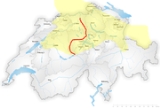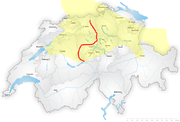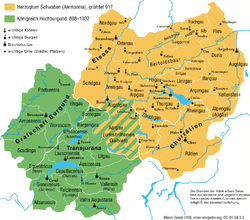
Brünig-Napf-Reuss line
Encyclopedia


Brünig Pass
Brünig Pass connects the Bernese Oberland and central Switzerland, linking Meiringen in the canton of Bern and Lungern in the canton of Obwalden.Rail services are provided by the Zentralbahn between Luzern and Interlaken.-See also:...
along the Napf
Napf
Napf is a mountain on the border between the cantons of Berne and Lucerne. It is the summit of the Napfgebiet region, north of Bernese Alps.-Weather:...
region to the Reuss River
Reuss River
The Reuss is a river in Switzerland. With a length of and a drainage basin of , it is the fourth largest river in Switzerland...
(which joins the Aare at Brugg
Brugg, Switzerland
Brugg is a municipality in the Swiss canton of Aargau and is the seat of the district of the same name. The city is located at the confluence of the Reuss, Aare, and Limmat Rivers, with the Aare flowing through the city’s old town...
), it partly separates western (Bernese German
Bernese German
Bernese German is the dialect of High Alemannic German spoken in the Swiss plateau part of the canton of Bern and in some neighbouring regions.- Varieties :There is a lot of regional variation within Bernese German dialects...
) and eastern (Zurich German
Zürich German
Zürich German, or Züritüütsch is the High Alemannic dialect spoken in the Canton of Zürich, Switzerland.It is divided in six sub-dialects, covering the entire Canton with the exception of the parts north of the Thur and the Rhine....
) varieties of High Alemannic, although some places east of the line belong to the western dialect group (Schwyz
Schwyz
The town of is the capital of the canton of Schwyz in Switzerland.The Federal Charter of 1291 or Bundesbrief, the charter that eventually led to the foundation of Switzerland, can be seen at the Bundesbriefmuseum.-History of the toponym:...
, Zug
Zug
Zug , is a German-speaking city in Switzerland. The name ‘Zug’ originates from fishing vocabulary; in the Middle Ages it referred to the right to ‘pull up’ fishing nets and hence to the right to fish.The city of Zug is located in the Canton of Zug and is its capital...
). The line runs across the cantons of Lucerne
Canton of Lucerne
Lucerne is a canton of Switzerland. It is located in the centre of Switzerland. The population of the canton is . , the population included 57,268 foreigners, or about 15.8% of the total population. The cantonal capital is Lucerne.-History:...
and Aargau
Aargau
Aargau is one of the more northerly cantons of Switzerland. It comprises the lower course of the river Aare, which is why the canton is called Aar-gau .-History:...
.
Some historians (see M. Burger 2001) argue that this cultural boundary is of greater importance historically than the French-German language boundary (the Röstigraben
Röstigraben
The Röstigraben, , literally ‘Rösti ditch’, also transcribed Röschtigraben in order to reflect the Swiss German pronunciation , is a humorous term describing the dividing line between the German-speaking and the French-speaking Romands parts of Switzerland with their respecitve cultural differences...
). The line coincides with the traditional distribution of Simmental Cattle
Simmental Cattle
Simmental cattle are a versatile breed of cattle originating in the valley of the Simme river, in the Bernese Oberland of western Switzerland.-European origin:...
(west) vs. Braunvieh
Braunvieh
Braunvieh is a breed of cattle originating from Switzerland. Braunvieh cattle imported to the United States in the 19th century were the origin of the modern, Brown Swiss cattle breed. Since the 1960s, Brown Swiss cattle have been crossed back into the Braunvieh stock of Europe...
(east). The line also corresponds to the frontline during the Swiss peasant war of 1653
Swiss peasant war of 1653
The Swiss peasant war of 1653 was a popular revolt in the Old Swiss Confederacy at the time of the Ancien Régime. A devaluation of Bernese money caused a tax revolt that spread from the Entlebuch valley in the Canton of Lucerne to the Emmental valley in the Canton of Bern and then to the cantons of...
.
The High Alemannic regions west of the line correspond to medieval Argovia, the marches
Marches
A march or mark refers to a border region similar to a frontier, such as the Welsh Marches, the borderland between England and Wales. During the Frankish Carolingian Dynasty, the word spread throughout Europe....
between Burgundy and Alemannia.
East of the Brünig-Napf-Reuss line:
- SchwyzSchwyzThe town of is the capital of the canton of Schwyz in Switzerland.The Federal Charter of 1291 or Bundesbrief, the charter that eventually led to the foundation of Switzerland, can be seen at the Bundesbriefmuseum.-History of the toponym:...
- St. GallenSt. GallenSt. Gallen is the capital of the canton of St. Gallen in Switzerland. It evolved from the hermitage of Saint Gall, founded in the 7th century. Today, it is a large urban agglomeration and represents the center of eastern Switzerland. The town mainly relies on the service sector for its economic...
- ZugZugZug , is a German-speaking city in Switzerland. The name ‘Zug’ originates from fishing vocabulary; in the Middle Ages it referred to the right to ‘pull up’ fishing nets and hence to the right to fish.The city of Zug is located in the Canton of Zug and is its capital...
- ZürichZürichZurich is the largest city in Switzerland and the capital of the canton of Zurich. It is located in central Switzerland at the northwestern tip of Lake Zurich...
West of the Brünig-Napf-Reuss line:
- AarauAarauAarau is the capital of the northern Swiss canton of Aargau. The city is also the capital of the district of Aarau. It is German-speaking and predominantly Protestant. Aarau is situated on the Swiss plateau, in the valley of the Aar, on the river's right bank, and at the southern foot of the Jura...
- Bern
- LiestalLiestalLiestal is the capital of the canton of Basel-Country in Switzerland, south of Basel.It is an industrial town with a cobbled-street Old Town.-History:...
- SolothurnSolothurnThe city of Solothurn is the capital of the Canton of Solothurn in Switzerland. The city also comprises the only municipality of the district of the same name.-Pre-roman settlement:...

